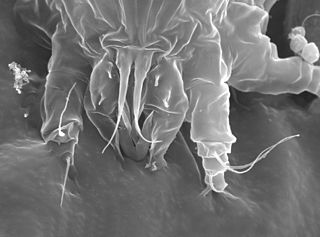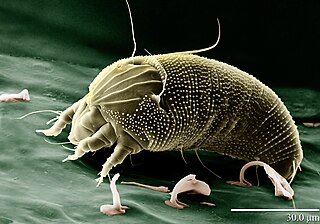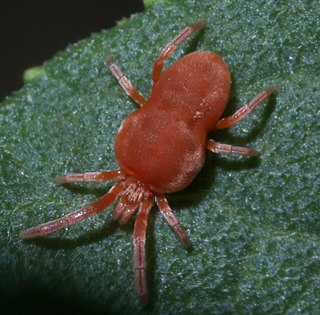Related Research Articles

The Acari are a taxon of arachnids that contains mites and ticks. The diversity of the Acari is extraordinary and their fossil history goes back to at least the early Devonian period. Acarologists have proposed a complex set of taxonomic ranks to classify mites. In most modern treatments, the Acari are considered a subclass of the Arachnida and are composed of two or three superorders or orders: Acariformes, Parasitiformes, and Opilioacariformes; the latter is often considered a subgroup within the Parasitiformes. The monophyly of the Acari is open to debate, and the relationships of the acarines to other arachnids is not at all clear. In older treatments, the subgroups of the Acarina were placed at order rank, but as their own subdivisions have become better understood, treating them at the superorder rank is more usual.

Raoiella indica, commonly known as the red palm mite, is a species of mite belonging to the family Tenuipalpidae. A pest of several species of palm in the Middle East and South East Asia, it is now becoming established throughout the Caribbean. The invasion of this species is the biggest mite explosion ever observed in the Americas.

Floracarus perrepae is a species of herbivorous mite belonging to the family Eriophyidae. It is native to Australia (Queensland), China and New Caledonia. As it is known to attack and eat the invasive fern species Lygodium microphyllum, it is being considered for use as a biological pest control agent in Florida.
Austrophthiracarus is a genus of mites in the family Steganacaridae.

Aceria anthocoptes, also known as the russet mite, rust mite, thistle mite or the Canada thistle mite, is a species of mite that belongs to the family Eriophyidae. It was first described by Alfred Nalepa in 1892.

Brevipalpus phoenicis, also known as the false spider mite, red and black flat mite, and in Australia as the passionvine mite, is a species of mite in the family Tenuipalpidae. This species occurs globally, and is a serious pest to such crops as citrus, tea, papaya, guava and coffee, and can heavily damage numerous other crops. They are unique in having haploid females, a condition caused by a bacterium that change haploid males into females.
Charletonia cuglierensis is a species of mite belonging to the family Erythraeidae, so named after its type locality. C. cuglierensis belongs to the group of species which possess two setae between coxae II and III. It differs from its cogenerate species by length measurements. It was first found in Sardinia, 6 kilometres (3.7 mi) south of Cuglieri.
Leptus pozzoicus is a species of mite. It is named after Porto Pozzo, near Santa Teresa Gallura, the place where the species was first collected. L. pozzoicus belongs to the group of species with two palpgenualae, and that have over four setae between coxalae II and III. It differs from its cogenerate species by various length measurements.
Charletonia austisensis is a species of mite belonging to the family Erythraeidae. C. austisensis belongs to the species group with two setae between coxae II and III. It differs from its cogenerate species by various length measurements. The species was first found in Austis, Sardinia, after which it is named.
Abrolophus mirabelae is a species of mite belonging to the family Erythraeidae. It belongs to the group of species that have comb-like setae.
Erythraeus moeritzensis is a species of mite belonging to the family Erythraeidae. It belongs to the group of species that has a basifemoral, setal formula 3-3-3.
Allothrombium polikarpi is a species of mite belonging to the family Trombidiidae, first described from Greece.
Podothrombium manolatesicus is a species of mite belonging to the Trombidiidae family, first derived from Greece.
Erythraeus (Zaracarus) passidonicus is a species of mite belonging to the family Erythraeidae, first described from Greece.
Erythraeus (Zaracarus) kastaniensis is a species of mite belonging to the family Erythraeidae, first described from Greece.
Charletonia samosensis is a species of mite belonging to the family Erythraeidae, first described from Greece.
Charletonia kalithensis is a species of mites belonging to the family Erythraeidae, first described from Greece.
Magdalena Kathrina Petronella Smith Meyer was a South African acarologist who was regarded as a world authority on plant-feeding mites of agricultural importance and was known as the "mother of red-spider mites of the world". She described more than 700 new species and 25 new genera, mostly of mites of agricultural importance. Meyer was involved in the promotion of biological control of mites using predatory mites, spiders and insects.

Allothrombium is a genus of mites belonging to the family Trombidiidae.
Charletonia is a genus of mite belonging to the family Erythraeidae.
References
- ↑ Haitlinger, R. Y. S. Z. A. R. D. "New records of mites (Acari: Prostigmata: Erythraeidae, Trombidiidae, Eutrombidiidae) from France, Liechtenstein and Switzerland, with descriptions of three new species." Systematic and Applied Acarology 12.1 (2007): 55.